License Server
With a network license, any number of users on the same network can access the product license simultaneously. The License Server program, which must be installed on a server, controls the distribution of licenses to users.
The License Server can be downloaded from the FVA Download Center.
Installation requirements
64-bit Windows operating system
Administrator rights on the target computer
600 MB free hard disk space
Port 5006 (inbound) must be enabled in the firewall
The server uses the HTTP protocol, and should therefore only be used on the LAN/intranet for security reasons.
Write permissions on the installation directory
Starting the License Server
The "application" and "service" folders are created in the specified directory during the installation. The License Server can be managed by clicking on the desktop shortcut or the LicServer.exe file in the "application" folder.
 |
Logging in
A login dialog appears when starting the License Server for the first time.
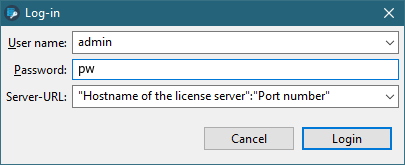
Username | admin |
Password | pw |
Server address | "Hostname of the license server": "port number" |
Example server address | BLNSCR2033:5006 or 194.234.501.200:5006 (IP address of the server) |
Notice
The administrator password should be changed after the first login.
Selecting licenses
Multiple licenses of the file type .lic can be added via upload license. The following information is shown for each license in the overview:
License ID
Maximum number of users
Number of users currently using the license
Order date
Expiration date
Name of licensee
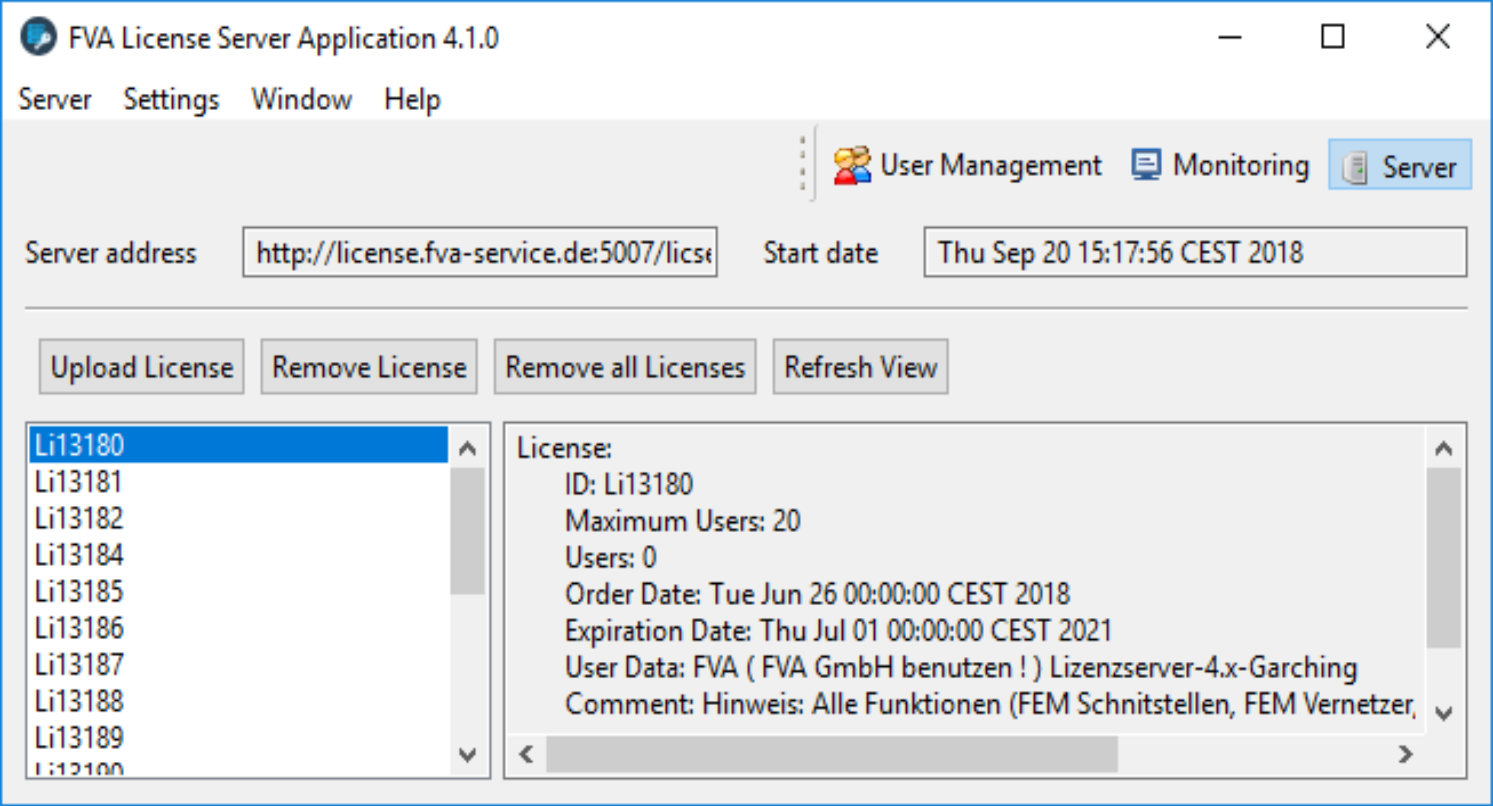
Rights management
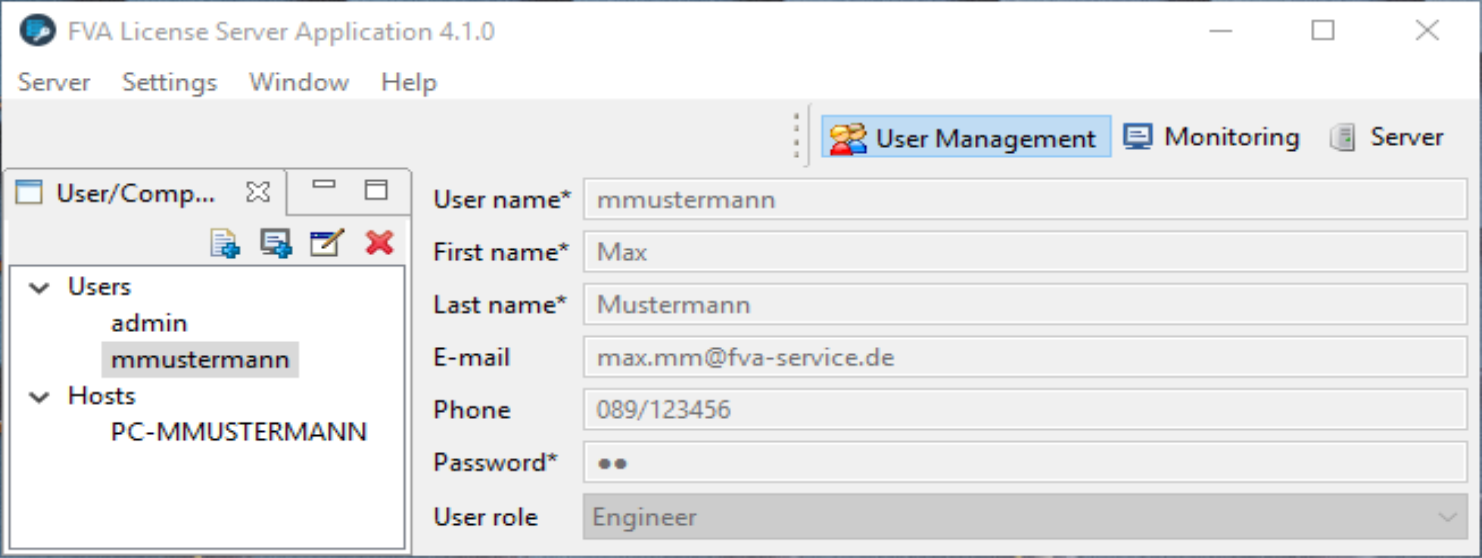
Individual user profiles can be created under the user management tab. A username and password must be specified. The user can provide these details to login to the FVA-Workbench during the license query.
Caution
Usernames and passwords may not contain special characters (<, &, %, etc.). If these characters are used, the License Server will no longer be able to correctly load the user data after restarting the service.
This will be fixed in a future release of the License Server. All versions of the License Server up to and including version 4.3 are affected.
Refer to Troubleshooting checklist
Notice
Multiple clients can login using the same username.
The same user can login multiple times using the same host.
A host can also be created. In this case, the computer name is used to login for the license query; no other login details are needed.
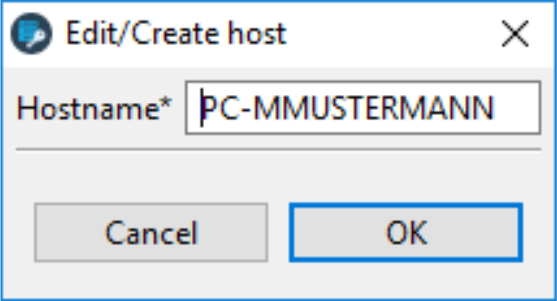
The computer name can also be specified without a domain suffix.
Starting the FVA-Workbench with a server license
To start the FVA-Workbench with a floating license (server license), the following parameters must be specified at startup:
License type | Server license |
Servername:Port | "Hostname of license server": "port number" |
Once both fields have been completed, a license can be selected in the drop-down menu.
Login information must only be provided to access a user profile. No login data is required for a host login.

License Server service
During installation of the License Server, a service called FVAWBLicenseService4.1 is created and runs in the background.
The service can be started or stopped via the Microsoft Service Control Panel. To start the Microsoft Service Control Panel, enter the command services.msc in the search field of the Windows task bar.
Monitoring sessions
All active sessions can be monitored, and disconnected if necessary, under the "Monitoring" tab.
User statistics are available in .json format, as long as they are enabled in the server settings.
For the GET setting (unauthorized access):
Browser: http://"Servername":5006/licserver/stats
MS-PowerShell: Invoke-WebRequest http://"Servername":5006/licserver/stats
For the POST setting (authorized access):
MS-PowerShell: Invoke-WebRequest http://"Servername":5006/licserver/stats -Method POST -Body @{user='admin';pwd='pw'}
To save the results of the query as a file, the following MS-PowerShell command can be used:
MS-PowerShell: Invoke-WebRequest http://“Servername":5006/licserver/stats -OutFileC:\out.txt
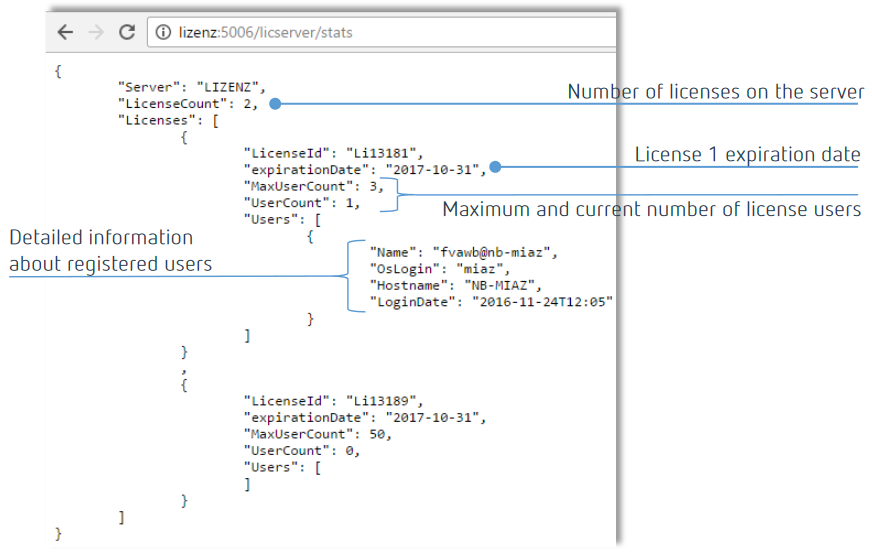
Uninstalling
Before the License Server can be uninstalled, LicServer.exe should be terminated. The server can then be uninstalled under "Apps & features“ in the Control Panel.
All files created in C:\FVA\Lizenzserver_4.1_x64 during installation (such as uploaded licenses and settings) are not deleted during the uninstall.
User migration when updating the License Server
The file ProfileStore.xml is saved from the installation directory of the old version of the License Server in order to migrate users from version 3.3.0/4.0.0 to License Server 4.1.0. (C:\FVA\FVA-Lizenzserver_3.3\Service\data) or (C:\FVA\FVA-Lizenzserver_4.0\Service\data)
This file is then moved to the same location in the License Server 4.1.0 installation directory.
Setting up HTTPS encryption
As of license server version 4.2.0 and FVA-Workbench version 9.0.0, data can optionally be transferred between the license server and FVA-Workbench via the HTTPS protocol.
An SSL certificate is required to enable connections via HTTPS. A self-signed certificate can be created for use on the intranet or for test purposes.
Create certificate
Create your own certificate
The keytool program, which is part of the Java JRE, can be used for the creation. The keytool is located in the installation directory of the license server -> jre/bin. The following files are generated below:
fvasslkeystore.jks (Keystore)
localhost.cert (Certificate)
clienttrust.jks (Truststore)
Open the command prompt in the installation directory of the license server and execute the following commands:
1. fvasslkeystore.jks
keytool -genkey -noprompt -trustcacerts -keyalg RSA -alias localcertificate -keypass changeit -keystore fvasslkeystore.jks -storepass changeit -dname CN=localhost
The domain name should correspond to the server domain (here localhost).
Output: fvasslkeystore.jks
2. localhost.certlocalhost.cert
keytool -export -keystore fvasslkeystore.jks -alias localcertificate -file localhost.cert -storepass changeit
Output: clienttrust.jks
3. clienttrust.jks
keytool -import -v -trustcacerts -alias localcert -file localhost.cert -keystore clienttrust.jks -storepass changeit
Output: clienttrust.jks
Configuration
License server configuration
1. Copy the file fvasslkeystore.jks to the installation directory of the license server/service.
2. Add the following 2 parameters to the file FVAWBLicenseService4.2.vmoptions in the same directory:
-Djavax.net.ssl.keyStore=fvasslkeystore.jks -Djavax.net.ssl.keyStorePassword=changeit
3. The HTTP and HTTPS ports can be adjusted in the installation directory/Service/data/config.ini file:
internationalizing=en_en [Startup]= LogFileFolder=C\:\\InstallationTest\\Lizenzserver_4.1_x64\\Service/logs/ protocolUserSessions=false Port=5006 StartupTime=Tue Jan 16 14\:47\:00 CET 2024-383 generateStatus=POST Servlet=/licserver/lgt Log-Filesize=30 HttpsPort=443
Note
If the HttpsPort specification is missing, no https port will be opened.
If the port specification is missing, no http port will be opened.
4. Copy the file clienttrust.jks to the installation directory/application.
5. Add the following 2 parameters to the LicServer.ini file in the same directory:
-Djavax.net.ssl.trustStore=clienttrust.jks -Djavax.net.ssl.trustStorePassword=changeit
Configuration of the FVA-Workbench
1. Copy the file clienttrust.jks to the installation directory of the FVA-Workbench.
2. Add the following 2 parameters to the file FVAWorkbench.ini in the same directory:
-Djavax.net.ssl.trustStore=clienttrust.jks -Djavax.net.ssl.trustStorePassword=changeit
Login to the license server
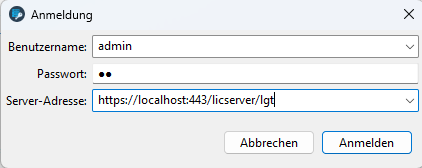
In the license server login dialog, the https protocol and the corresponding port must be specified in the server address field.
Java runtime environment
A Java runtime environment is required to operate the license server. This is installed by default and is located in the installation directory in the /jre folder.
The license server can also be started with a runtime environment of your choice. To do this, the following files in the installation directory must be adapted:
Installation directory/Application/LicServer.ini
Installation directory/Service/FVAWBLicenseService4.2.vmoptions
In both files the entry ../jre/bin/javaw.exe be replaced by the path to the desired runtime environment. If the entry is omitted, the runtime environment stored in the operating system is used.
Note
-vm ../jre/bin/javaw.exe
The -vm key and the corresponding path to the JRE must be on consecutive lines.